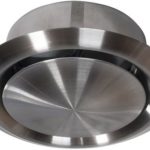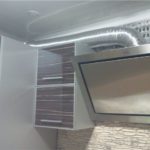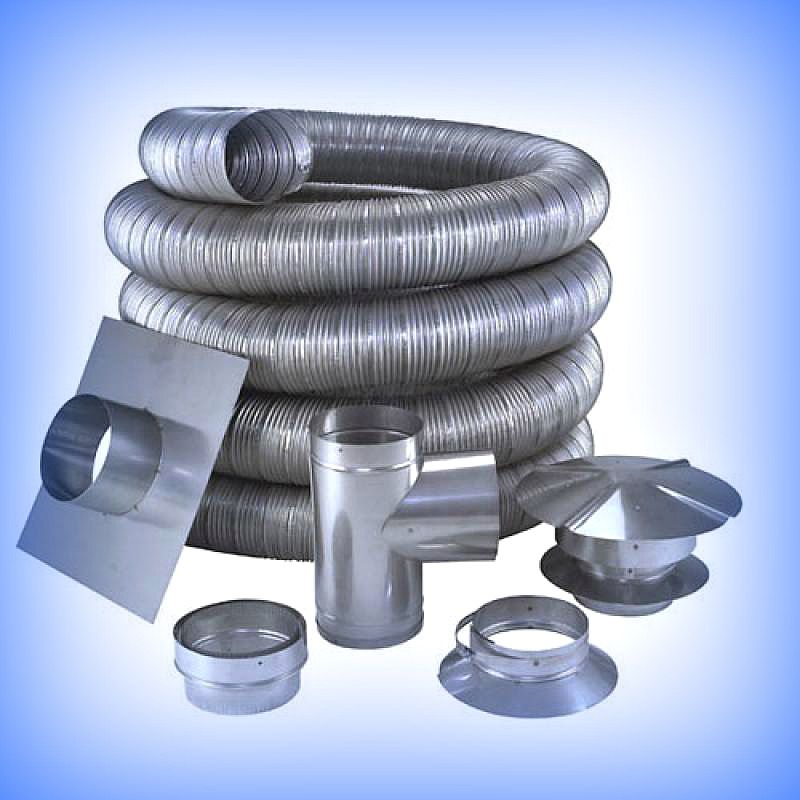Ventilation box
The content of the article
- External and internal characteristics
- What kind of ventilation box can there be?
- Restoring an outdated ventilation duct using modern tools and materials
- Installation of ventilation ducts
- How to protect the ventilation box from fire
- Methods for soundproofing ventilation ducts
- Providing sound insulation with your own hands
- Conclusion
External and internal characteristics
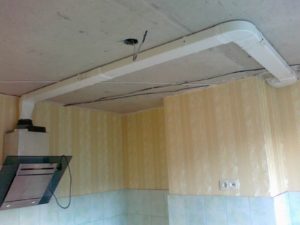 The ventilation duct is relevant for such premises as industrial premises, kitchens, and, less often, bathrooms. Here it helps to remove air that is uncomfortable for a person into a ventilation shaft or to the street until it is dispersed throughout the room.
The ventilation duct is relevant for such premises as industrial premises, kitchens, and, less often, bathrooms. Here it helps to remove air that is uncomfortable for a person into a ventilation shaft or to the street until it is dispersed throughout the room.
The dimensions of the air duct make it a noticeable design element, which is why manufacturers pay considerable attention to its appearance; with proper care, it looks at least neat. Many models add elegance to the interior.
The main parameter of the ventilation duct is throughput. Its calculation for a person without specialized education has a rather complex formula; there are many tables reflecting air exhaust depending on the dimensions of the structure.
The main principle is simple: corners and irregularities create obstacles to air movement; the more of them, the lower the throughput. To remove the same volume of air in this case, a larger cross-section or more powerful equipment is required.
The inner surface, like the outer one, can be smooth or corrugated. Smooth boxes are more hygienic and easy to clean, but require experience to install.
What kind of ventilation box can there be?
There is a wide variety of boxes on the market. Many companies offer to make them to individual sizes. The design is simple; if desired, you can make it yourself.
Popular and non-standard sizes of ventilation ducts for premises
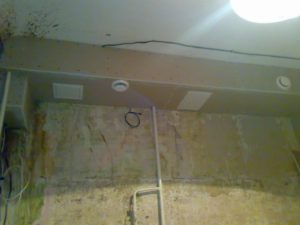 You can find a box of any size on sale or order it, but the need to connect it with elements of other structures (kitchen hood, ventilation shaft) makes it reasonable to use standard sizes.
You can find a box of any size on sale or order it, but the need to connect it with elements of other structures (kitchen hood, ventilation shaft) makes it reasonable to use standard sizes.
For flat channels, the popular sizes are 204x60 mm, 110x55 mm, and the dimensions 120x60 mm are used somewhat less frequently. To increase air removal, manufacturers offer 220x90 mm channels.
Round boxes are most often produced with a diameter of 100, 125, 150, and 200 mm.
Air ducts of rarer sizes can be found on sale. Many companies produce according to individual customer sizes.
Important! When purchasing or ordering a box of rare or non-standard sizes, take care of the transition and connecting elements necessary to form corners with parts of the structure, attach to the hood and the ventilation hole.
Classification of the ventilation duct according to other parameters (material and shape)
The most common materials are metal and plastic. The choice depends on the operating conditions, sometimes on personal preferences.
Metal ones are made of stainless or galvanized steel. They:
- durable;
- hygienic and relatively easy to keep clean;
- easy to install;
- They are much more expensive than plastic ones.
Plastic ones have their own characteristics:
- lungs;
- cheap;
- do not rust;
- susceptible to contamination by bacteria and fungi.
You can make a ventilation duct yourself from any available material, provided it is sealed.
The shape of the boxes is usually rectangular (flat), round or square. Upon individual order, it is possible to produce other shapes, for example, triangular or pentagonal.
What is special about a flat ventilation box?
 Flat systems are used for rational, aesthetic organization of space. They can be combined with furniture, walls, or hidden behind a suspended or suspended ceiling.
Flat systems are used for rational, aesthetic organization of space. They can be combined with furniture, walls, or hidden behind a suspended or suspended ceiling.
The disadvantages include:
- reduced draft due to the presence of corners, as a result, a larger cross-section or more powerful exhaust equipment is required;
- increased noise level.
Restoring an outdated ventilation duct using modern tools and materials
As a rule, restoration is required for the duct that provides general house ventilation. There are different reasons for recovery, the most common are:
- previous illegal redevelopment;
- violation of air exchange, characteristic of old premises.
Tools you may need:
- level;
- roulette;
- circular or regular saw;
- hammer;
- screwdriver;
- container for solution;
- trowel (trowel).
Different materials may be required:
- pipes;
- building blocks;
- brick;
- masonry mortar;
- drywall;
- Fibreboard, chipboard;
- metallic profile;
- screws.
Restoring the box:
 clear the ventilation ducts; to do this you will have to remove the floor and ceiling coverings where the air ducts pass;
clear the ventilation ducts; to do this you will have to remove the floor and ceiling coverings where the air ducts pass;- study the cross-section;
- select suitable materials;
Important! When choosing materials, you need to be guided by the cross-section of the air ducts, as well as the principle of tightness. Design options can be different: pipes or corrugations lined with lightweight material (chipboard, plasterboard); a shaft made of durable materials (aerated concrete, brick, etc.). Regardless of the materials chosen, it is important to ensure that the air path is sealed. A design using pipes will require vents for ventilation of your apartment.
- Build a structure using the selected materials according to the level;
- Provide an opening in the ventilation shaft for air exchange in your apartment.
After erecting the box, let it dry. Afterwards you can begin to design and decorate it.
Installation of ventilation ducts
Correct preparation plays an important role for installation:
- throughput is calculated;
- the desired section is selected;
- suitable connecting and transition elements are selected;
- parts of the installation are marked and, if necessary, cut.
The prepared elements are assembled into a single system, attached on one side to a hole in the wall, on the other side, probably to the hood.
Particular attention should be paid to sealing at joints. Be sure to use rubber gaskets and/or sealant.
How to protect the ventilation box from fire
 The most common and accessible methods of fire protection:
The most common and accessible methods of fire protection:
- coating the surface of the box with non-flammable paints or mastics;
- wrapping the structure in non-flammable materials.
Among the modern methods we can note:
- fire sensors that block the flow of air to the fire area;
- fire extinguishing systems that supply limestone to the fire site;
- spark arresters.
Such protective equipment is quite expensive, most of them are designed for large-sized ventilation systems. They are used in industrial premises.
Methods for soundproofing ventilation ducts
Operating ventilation often creates noise caused by inaccurate installation or materials.
You can reduce noise levels by:
- mineral wool;
- fiberglass;
- rubber slabs;
- porous materials;
- organic fiber.
Providing sound insulation with your own hands
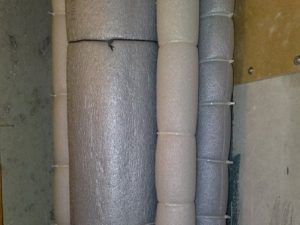 The ventilation duct is covered in several layers with the selected material to absorb sound. All layers must be thoroughly cleaned, after which they are well fixed using an adhesive base or adhesive tape. If insulating materials have a reflective layer, it should face outward. Fastening the material overlapping significantly increases the effectiveness of insulation.
The ventilation duct is covered in several layers with the selected material to absorb sound. All layers must be thoroughly cleaned, after which they are well fixed using an adhesive base or adhesive tape. If insulating materials have a reflective layer, it should face outward. Fastening the material overlapping significantly increases the effectiveness of insulation.
The resulting structure is often sheathed with decorative plates attached to a metal profile.
Conclusion
The ventilation duct is a fairly simple design. Work on its installation, repair and maintenance require low qualifications. Specialists perform work quickly and at a high level. However, if you have a basic understanding of repairs, time and desire, you can do everything yourself.

